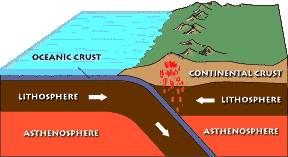Earthquakes
Thousands of earthquakes per year are seen in this region due to the constant tectonic activity, making the Aleutian islands the most seismically active area in the United States of America. Faulting within the subduction zone (Aleutian Megathrust) as well as within the subducting and overriding plates themselves accounts for the majority of earthquakes that occur. [2] Some smaller magnitude earthquakes are also caused by the volcanic activity of the Aleutian Arc. The regionality of the earthquakes makes it possible for inter-plate and intra-plate events to be differentiated. [2] The majority of events have been noted as having a thrusting mechanism, which denotes them as earthquakes occurring from the interface of a plate. [2] Strike-slip and normal faulting does occur in shallow events, where the depth of the event is less than 30 km deep. [2] Events with a normal fault mechanism tend to occur where the Pacific plate bends as it forms the Aleutian Trench, whereas strike-slip mechanisms are concentrated inland along the axis of the islands themselves. [2]
The constant activity near the Aleutian Arc has resulted in an area prone to high magnitude earthquakes. One major earthquake (Mw ≥ 8) occurs every 13 years on average, and strong magnitude earthquakes (Mw 6–7) occur an average of six times per year. [6] The rapid conversion and the gentle subduction angle of the Pacific plate under the North American plate also caused a back-arc region of tectonic deformation that spans 700 km from the Aleutian Arc into the interior of Alaska to form. [6] These conditions have allowed for a multitude of major earthquakes to be measured throughout Alaska's history. Most major earthquakes measured in the region tend to be caused by ruptures in the gentle subduction interface between the subducting and overriding plates. [6]


